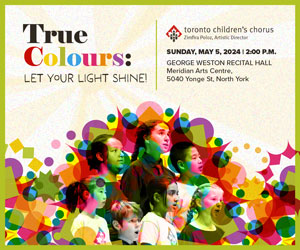Review
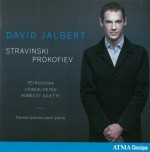 David Jalbert already has five recordings in the ATMA catalogue. His newest is Stravinski – Prokofiev Pétrouchka, L’oiseau de feu, Roméo et Juliette – Transcriptions pour piano (ATMA Classique ACD2 2684). It shows why he’s considered one of the younger generation’s finest pianists. His performance of Danse russe from Pétrouchka explodes into being with astonishing speed and alacrity. Jalbert possesses a sweeping technique that exudes ease and persuasive conviction.
David Jalbert already has five recordings in the ATMA catalogue. His newest is Stravinski – Prokofiev Pétrouchka, L’oiseau de feu, Roméo et Juliette – Transcriptions pour piano (ATMA Classique ACD2 2684). It shows why he’s considered one of the younger generation’s finest pianists. His performance of Danse russe from Pétrouchka explodes into being with astonishing speed and alacrity. Jalbert possesses a sweeping technique that exudes ease and persuasive conviction.
The three extracts from L’Oiseau de feu require, and Jalbert obviously has it, complete command of the keyboard for the Danse that begins the set. Equally demanding is the introspection necessary for the following Berceuse. The Finale builds to a colossal orchestral finish that loses nothing in this transcription for piano.
According to the disc’s informative liner notes, the ten pieces from Prokofiev’s ballet Romeo and Juliet Op.75 are from Prokofiev’s original piano score, and owing to the composer’s facility with the instrument, are highly idiomatic. One of the set’s most engaging pieces is The Montagues and the Capulets, driven rhythmically by its relentless bassline. Jalbert has a complete understanding of these three stage works and the contemporary language their composers used to tell their stories.
Review
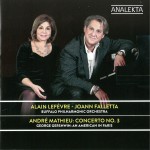
In 2008 the original autograph score for two pianos was discovered in Ottawa. Since then, composer and conductor Jacques Marchand has prepared a critical edition that is faithful to the original manuscript. This is its first full recording. It has all the sweeping gestures of its period and a devilishly difficult piano part. Lefèvre’s performance at the keyboard is masterful. He and the BPO perform the work with astonishing authenticity, restoring a fascinating chapter to Canadian music history of that period.
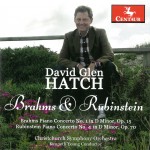 American pianist David Glen Hatch exploits his pianistic link to Brahms in Brahms & Rubinstein (Centaur CRC 3565/3566). Brahms’ student Carl Friedberg taught at Juilliard in the late 1940s; Hatch’s own teacher Joanne Baker won an audition to study there with Friedberg. Hatch recalls numerous instructions from Baker, handed down by Friedberg from Brahms, about his intentions for various passages in the Piano Concerto No.1 in D Minor Op.15. It’s fascinating to consider the extent to which Hatch’s performance is connected to the composer in this way. Hatch’s approach overall is quite deliberate in his slightly slower tempi. The second movement in particular reveals numerous opportunities to dwell on phrases and Brahms’ characteristic harmonic shifts.
American pianist David Glen Hatch exploits his pianistic link to Brahms in Brahms & Rubinstein (Centaur CRC 3565/3566). Brahms’ student Carl Friedberg taught at Juilliard in the late 1940s; Hatch’s own teacher Joanne Baker won an audition to study there with Friedberg. Hatch recalls numerous instructions from Baker, handed down by Friedberg from Brahms, about his intentions for various passages in the Piano Concerto No.1 in D Minor Op.15. It’s fascinating to consider the extent to which Hatch’s performance is connected to the composer in this way. Hatch’s approach overall is quite deliberate in his slightly slower tempi. The second movement in particular reveals numerous opportunities to dwell on phrases and Brahms’ characteristic harmonic shifts.
As substantial as the Brahms concerto is, the Rubinstein Concerto for Piano and Orchestra No.4 in D Minor Op.70 seems an even grander conception. It may have to do with Rubenstein’s orchestrations, but somehow Hatch seems truly in his element with the composer’s great pianistic gestures. The concertos are an excellent pairing for this two-disc recording.
Review
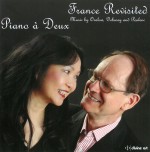 Robert and Linda Ang Stoodley style themselves as Piano à Deux. Their new disc, France Revisited – Music by Onslow, Debussy and Poulenc (Divine Art dda 25132) is an example of piano four hands performance at its very best. One of the disc’s many treats is the appearance of music by George Onslow. Because his oeuvre is largely for chamber strings, his very few piano works tend to be overlooked. The unique voice of this 19th-century composer is deeply intriguing as heard in the Sonata for Piano Four Hands No.1 in E Minor Op.7. It’s surprisingly forward looking despite its early catalogue entry.
Robert and Linda Ang Stoodley style themselves as Piano à Deux. Their new disc, France Revisited – Music by Onslow, Debussy and Poulenc (Divine Art dda 25132) is an example of piano four hands performance at its very best. One of the disc’s many treats is the appearance of music by George Onslow. Because his oeuvre is largely for chamber strings, his very few piano works tend to be overlooked. The unique voice of this 19th-century composer is deeply intriguing as heard in the Sonata for Piano Four Hands No.1 in E Minor Op.7. It’s surprisingly forward looking despite its early catalogue entry.
Petite Suite delivers all the rich impressionistic orchestrations with which we associate Claude Debussy, and Piano à Deux are consistently excellent in how they portray the composer’s lightly programmatic intent.
The duo has also transcribed the Poulenc Chansons de l’amour et de la guerre, and done so with a gifted ear that preserves the wistful nostalgia that Poulenc infused into each song.
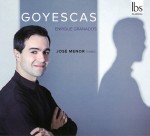 José Menor is an extraordinary pianist with a fearsome technique and unrivalled fluidity of touch. His new recording Goyescas – Enrique Granados (IBS Classical IBS-82017) demonstrates how he brings these gifts to his exploration of this major composition of Spanish piano music. Menor goes to considerable effort in his liner notes to explain how this music captured his imagination and compelled him to study it from a composer’s perspective rather than just a pianist’s. His study of the original manuscripts recommended by the Granados family helped him profoundly in discerning the composer’s intent in writing the suite, which deals with the course of love and death.
José Menor is an extraordinary pianist with a fearsome technique and unrivalled fluidity of touch. His new recording Goyescas – Enrique Granados (IBS Classical IBS-82017) demonstrates how he brings these gifts to his exploration of this major composition of Spanish piano music. Menor goes to considerable effort in his liner notes to explain how this music captured his imagination and compelled him to study it from a composer’s perspective rather than just a pianist’s. His study of the original manuscripts recommended by the Granados family helped him profoundly in discerning the composer’s intent in writing the suite, which deals with the course of love and death.
Menor admits being attracted by the work’s many, deep contrasts and its expressive intensity. This is most powerfully evident in El amor y la muerte. It’s astonishing to imagine that this century-old work contains such modern tone clusters and rhythmic freedom. Under the hands of Menor it becomes a revealing expression, ahead of its time, and potently magical. The suite is slightly abridged for lack of recording space but the disc does include a rare performance of a single short manuscript, Crepúsculo, that may have been Granados’ first draft of some of the suite.
Review
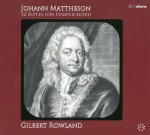
Review
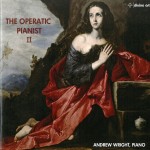
Review
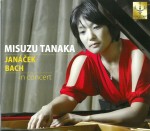
Tanaka approaches Janáček with an intent to uncover the inspired simplicity of his music. She moves through the numerous parts of Books 1 and 2 with thoughtful deliberation, capturing the essence of the composer’s evocative titles: Words Fail, Unutterable Anguish, In Tears, for example. Her playing is as perfect for Janáček as it is for Bach. What a wonderfully unlikely pair.
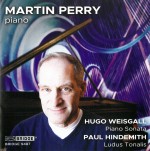
In the same vein, the Hindemith Ludus Tonalis has an illuminating subtitle: Studies in Counterpoint, Tonal Organization and Piano Playing. Hindemith writes a fugue in each of the 12 major keys, joined by interludes that help establish the new key. The opening Praeludium is played inverted and in reverse as the Postludium. It’s all rather cerebral, but Perry uses the distinct character of each fugue and interlude to colour the work in the most creative way. It’s a very engaging performance.

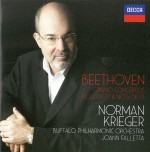 Norman Krieger puts two wonderful standard repertoire items on his newest CD: Beethoven Piano Concertos No.3 Op.37 & No.5 Op.73 (Decca DD41154 / 4815583). The Buffalo Philharmonic Orchestra under Joann Falletta performs beautifully with Krieger. They appear to have an agreement that the Concerto No.3 will not be overly furious and that the “Emperor” will similarly not be too imperiously grand. The outer movements of the concertos are sufficiently strong and emphatic where they need be, and the middle, slow movements are given ample space to breathe. The Concerto No.5 is especially effective in this way. The playing throughout is excellent. To top things off, the recordings are live concert performances that bring their own unique energy to the music. It’s a successful collaboration that shows promise.
Norman Krieger puts two wonderful standard repertoire items on his newest CD: Beethoven Piano Concertos No.3 Op.37 & No.5 Op.73 (Decca DD41154 / 4815583). The Buffalo Philharmonic Orchestra under Joann Falletta performs beautifully with Krieger. They appear to have an agreement that the Concerto No.3 will not be overly furious and that the “Emperor” will similarly not be too imperiously grand. The outer movements of the concertos are sufficiently strong and emphatic where they need be, and the middle, slow movements are given ample space to breathe. The Concerto No.5 is especially effective in this way. The playing throughout is excellent. To top things off, the recordings are live concert performances that bring their own unique energy to the music. It’s a successful collaboration that shows promise.



